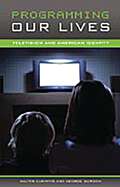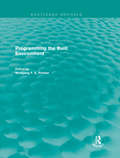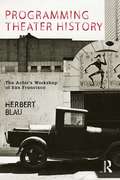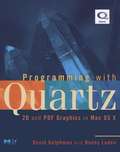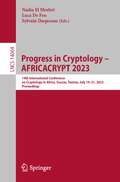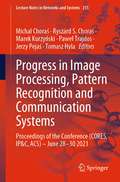- Table View
- List View
Programming Media Art Using Processing: A Beginner's Guide
by Margaret NobleProgramming Media Art Using Processing: A Beginner's Guide provides an entry-level exploration into visual design through computer programming using the open source and artist-friendly language, Processing. Used by hundreds of students, this learning system breaks lessons down into strategic steps towards fun and creative media art projects. This book provides a linear series of lessons with step-by-step examples that lead to beginning media art projects, including abstract designs, pixel landscapes, rollover animations, and simple video games. Computer programming can be overwhelming for the first-time learner, but this book makes the learning of code more digestible and fun through a full color, well-diagrammed, and deeply explained text presentation. Lessons are rhythmically broken down into digestible parts with code annotations and illustrations that help learners focus on the details one step at a time. The content is legible, flexible, and fun to work with because of its project-based nature. By following the lessons and producing the projects sequentially in this book, readers will develop the beginning foundational skills needed to understand computer programming basics across many languages and also explore the art of graphic design. Ultimately, this is a hands-on, practical guide. To learn more about Margaret Noble's work, please visit her artist's website and educator website.
Programming Our Lives: Television and American Identity
by Walter Cummins George GordonIn this timely examination of television and American identity, Cummins and Gordon take readers on an informed walk through the changes that TV has already wrought-and those still likely to confront us.Commercial television in America is less than 60 years old, yet it has had an enormous impact on what we like, what we do, what we know, and how we think. A family transplanted from the 1940s to the present day would certainly be stunned by a fundamentally different world: instead of gathering in the living room for a shared evening of radio, they would be scattered around the house to indulge their individual interests on one of a hundred cable channels; instead of a society with rigid racial and ethnic divisions, they would see people of different ethnicities in passionate embraces; and certainly they would see very different sets of values reflected across the board. They would, in short, find themselves in an unrecognizable America, one both reflected in and shaped by television, a medium that has been shown to have an unprecedented influence on our lives both for better and for worse.By focusing on the development of television within the cultural context that surrounds it, and drawing on such phenomena as quiz shows, comedy hours, the Kennedy assassination, the Olympics, sitcoms, presidential ads, political debates, MTV, embedded journalism, and reality TV, the authors reveal television's impact on essential characteristics of American life. They cover topics as diverse as politics, crime, medicine, sports, our perceptions, our values, our assumptions about privacy, and our unquenchable need for more things. In addition, they consider the future of the medium in the light of the proliferation of programming options, the prevalence of cameras and receivers in our lives, the growing links between TV and computers, and the crossed boundaries of television throughout the world.
Programming Paradigms in Graphics: Proceedings of the Eurographics Workshop in Maastricht, The Netherlands, September 2–3, 1995 (Eurographics)
by Remco C. Veltkamp Edwin H. BlakeThe papers in this volume are a good sampling and overview of current solutions to the problems of creating graphically based systems. This breadth of scope comes out of the closing discussion at the Fourth Eurographics Workshop on Object-Oriented Graphics. The fifth workshop, on Programming Paradigms in Graphics, set out to provide answers and alternatives to the shortcomings of object-oriented graphics. The presentations investigated the applicability, merits and problems of various programming paradigms in computer graphics for design, modelling and implementation. This book contains a revised selection of the best papers from the Fifth Eurograph ics Workshop on Programming Paradigms in Graphics, held 2-3 September 1995 in Maastricht, The ~etherlands. All papers at the workshop were subjected to a thorough review by at least three members of the international programme committee. The se lection for this book was based on further review and the papers also incorporate the relevant aspects of the discussions at the workshop. In past Eurographics workshops on Object-Oriented Graphics the prominent trend has been a discovery of the limits of object-orientation in graphics. The limitations of object-orientation were felt to lie in such areas as the expression of relationships between objects. This is an area of particular strength for the declarative languages, such as constraint-based languages. On the other hand, a notion of state has long been a problem in declarative languages and yet it is often seen as an essential aspect of graphical modelling, particularly in simulation and animation.
Programming the Built Environment (Routledge Revivals)
by Wolfgang F. E. PreiserArchitectural programming – the analysis of any given environment to satisfy users’ needs – has become a given prerequisite to the design process. The programming process is often a complicated one: users’ present and future needs must be identified; space allowances, often predetermined, must be considered; equipment must be accommodated; all in the most cost-effective way possible. The variety of user groups is as wide as the variety of functions architecture can shelter; moreover, the different structures and needs of clients that fall within the same use classification differs so greatly that every program presents a new challenge. You cannot, for example, use the same program for every hospital you design. In Programming the Built Environment, first published in 1985, noted architect Wolfgang F. E. Preiser has compiled a wide range of architectural programs demonstrating applications of basic principles for different client groups. This book will be of interest to students of architecture and planning.
Programming the Built Environment (Routledge Revivals)
by Wolfgang F. E. PreiserArchitectural programming – the analysis of any given environment to satisfy users’ needs – has become a given prerequisite to the design process. The programming process is often a complicated one: users’ present and future needs must be identified; space allowances, often predetermined, must be considered; equipment must be accommodated; all in the most cost-effective way possible. The variety of user groups is as wide as the variety of functions architecture can shelter; moreover, the different structures and needs of clients that fall within the same use classification differs so greatly that every program presents a new challenge. You cannot, for example, use the same program for every hospital you design. In Programming the Built Environment, first published in 1985, noted architect Wolfgang F. E. Preiser has compiled a wide range of architectural programs demonstrating applications of basic principles for different client groups. This book will be of interest to students of architecture and planning.
Programming Theater History: The Actor's Workshop of San Francisco
by Herbert Blau‘One of the great stories of the American theater..., the Workshop not only built an international reputation with its daring choice of plays and nontraditional productions, it also helped launch a movement of regional, or resident, companies that would change forever how Americans thought about and consumed theater.’ – Elin Diamond, from the Introduction Herbert Blau founded, with Jules Irving, the legendary Actor's Workshop of San Francisco, in 1952, starting with ten people in a loft above a judo academy. Over the course of the next 13 years and its hundred or so productions, it introduced American audiences to plays by Brecht, Beckett, Pinter, Genet, Arden, Fornes, and various unknown others. Most of the productions were accompanied by a stunningly concise and often provocative programme note by Blau. These documents now comprise, within their compelling perspective, a critique of the modern theatre. They vividly reveal what these now canonical works could mean, first time round, and in the context of 1950s and 60s American culture, in the shadow of the Cold War. Programming Theater History curates these notes, with a selection of the Workshop's incrementally artful, alluring programme covers, Blau's recollections, and evocative production photographs, into a narrative of indispensable artefacts and observations. The result is an inspiring testimony by a giant of American performance theory and practice, and a unique reflection of what it is to create theatre history in the present.
Programming Theater History: The Actor's Workshop of San Francisco
by Herbert Blau‘One of the great stories of the American theater..., the Workshop not only built an international reputation with its daring choice of plays and nontraditional productions, it also helped launch a movement of regional, or resident, companies that would change forever how Americans thought about and consumed theater.’ – Elin Diamond, from the Introduction Herbert Blau founded, with Jules Irving, the legendary Actor's Workshop of San Francisco, in 1952, starting with ten people in a loft above a judo academy. Over the course of the next 13 years and its hundred or so productions, it introduced American audiences to plays by Brecht, Beckett, Pinter, Genet, Arden, Fornes, and various unknown others. Most of the productions were accompanied by a stunningly concise and often provocative programme note by Blau. These documents now comprise, within their compelling perspective, a critique of the modern theatre. They vividly reveal what these now canonical works could mean, first time round, and in the context of 1950s and 60s American culture, in the shadow of the Cold War. Programming Theater History curates these notes, with a selection of the Workshop's incrementally artful, alluring programme covers, Blau's recollections, and evocative production photographs, into a narrative of indispensable artefacts and observations. The result is an inspiring testimony by a giant of American performance theory and practice, and a unique reflection of what it is to create theatre history in the present.
Programming Visual Illusions for Everyone (Vision, Illusion and Perception #2)
by Marco BertaminiIf you find visual illusions fascinating Programming Visual Illusions for Everyone is a book for you. It has some background, some history and some theories about visual illusions, and it describes in some detail twelve illusions. Some are about surfaces, some are about apparent size of objects, some are about colour and some involve movement. This is only one aspect of the book. The other is to show you how you can create these effects on any computer.The book includes a brief introduction to a powerful programming language called Python. No previous experience with programming is necessary. There is also an introduction to a package called PsychoPy that makes it easy to draw on a computer screen. It is perfectly ok if you have never heard the names Python or PsychoPy before. Python is a modern and easy-to-read language, and PsychoPy takes care of all the graphical aspects of drawing on a screen and also interacting with a computer. By the way, both Python and PsychoPy are absolutely free. Is this a book about illusions or about programming? It is both!
Programming with Quartz: 2D and PDF Graphics in Mac OS X (The Morgan Kaufmann Series in Computer Graphics)
by David Gelphman Bunny LadenWritten by members of the development team at Apple, Programming with Quartz is the first book to describe the sophisticated graphics system of Mac OS X. By using the methods described in this book, developers will be able to fully exploit the state-of-the-art graphics capabilities of Mac OS X in their applications, whether for Cocoa or Carbon development. This book also serves as an introduction to 2D graphics concepts, including how images are drawn and how color is rendered. It includes guidance for working with PDF documents, drawing bitmap graphics, using Quartz built-in color management, and drawing text. Programming with Quartz is a rich resource for new and experienced Mac OS X developers, Cocoa and Carbon programmers, UNIX developers who are migrating to Mac OS X, and anyone interested in powerful 2D graphics systems.This is the definitive guide to the revolutionary graphics system of Mac OS X that uses the Portable Document Format (PDF) as the basis of its imaging modelIt contains the latest on programming with Quartz for Mac OS X version 10.4Carefully crafted and extensive code examples show how to accomplish most of the drawing tasks possible with Quartz
Progress and New Trends in 3D Geoinformation Sciences (Lecture Notes in Geoinformation and Cartography)
by Jacynthe Pouliot, Sylvie Daniel, Frédéric Hubert and Alborz ZamyadiThe integration of the 3rd dimension in the production of spatial representation is largely recognized as a valuable approach to comprehend our reality, that is 3D. During the last decade developments in 3D Geoinformation (GI) system have made substantial progress. We are about to have a more complete spatial model and understanding of our planet in different scales. Hence, various communities and cities offer 3D landscape and 3D city models as valuable source and instrument for sustainable management of rural and urban resources. Also municipal utilities, real estate companies benefit from recent developments related to 3D applications. In order to present recent developments and to discuss future trends, academics and practitioners met at the 7th International Workshop on 3D Geoinformation. This book comprises a selection of evaluated, high quality papers that were presented at this workshop in May 2012. The topics focus explicitly on the last achievements (methods, algorithms, models, systems) with respect to 3D GeoInformation requirements. The book is aimed at decision makers and experts as well at students interested in the 3D component of geographical information science including GI engineers, computer scientists, photogrammetrists, land surveyors, urban planners, and mapping specialists.
Progress in Artificial Intelligence: 14th Portuguese Conference on Artificial Intelligence, EPIA 2009, Aveiro, Portugal, October 12-15, 2009, Proceedings (Lecture Notes in Computer Science #5816)
by Luís Seabra Lopes Nuno Lau Pedro Mariano Luís M. RochaThis book contains a selection of higher quality and reviewed papers of the 14th Portuguese Conference on Artificial Intelligence, EPIA 2009, held in Aveiro, Portugal, in October 2009. The 55 revised full papers presented were carefully reviewed and selected from a total of 163 submissions. The papers are organized in topical sections on artificial intelligence in transportation and urban mobility (AITUM), artificial life and evolutionary algorithms (ALEA), computational methods in bioinformatics and systems biology (CMBSB), computational logic with applications (COLA), emotional and affective computing (EAC), general artificial intelligence (GAI), intelligent robotics (IROBOT), knowledge discovery and business intelligence (KDBI), muli-agent systems (MASTA) social simulation and modelling (SSM), text mining and application (TEMA) as well as web and network intelligence (WNI).
Progress in Artificial Intelligence: 19th EPIA Conference on Artificial Intelligence, EPIA 2019, Vila Real, Portugal, September 3–6, 2019, Proceedings, Part I (Lecture Notes in Computer Science #11804)
by Paulo Novais Luís Paulo Reis Paulo Moura OliveiraThis book constitutes the refereed proceedings of the 19th EPIA Conference on Artificial Intelligence, EPIA 2019, held in Funchal, Madeira, Portugal, in September 2019. The 119 revised full papers and 6 short papers presented were carefully reviewed and selected from a total of 252 submissions. The papers are organized in 18 tracks devoted to the following topics: AIEd - Artificial Intelligence in Education, AI4G - Artificial Intelligence for Games, AIoTA - Artificial Intelligence and IoT in Agriculture, AIL - Artificial Intelligence and Law, AIM - Artificial Intelligence in Medicine, AICPDES - Artificial Intelligence in Cyber-Physical and Distributed Embedded Systems, AIPES - Artificial Intelligence in Power and Energy Systems, AITS - Artificial Intelligence in Transportation Systems, ALEA - Artificial Life and Evolutionary Algorithms, AmIA - Ambient Intelligence and Affective Environments, BAAI - Business Applications of Artificial Intelligence, GAI- General AI, IROBOT - Intelligent Robotics, KDBI - Knowledge Discovery and Business Intelligence, KRR - Knowledge Representation and Reasoning, MASTA - Multi-Agent Systems: Theory and Applications, SSM - Social Simulation and Modelling, TeMA - Text Mining and Applications.
Progress in Artificial Intelligence: 19th EPIA Conference on Artificial Intelligence, EPIA 2019, Vila Real, Portugal, September 3–6, 2019, Proceedings, Part II (Lecture Notes in Computer Science #11805)
by Paulo Moura Oliveira Paulo Novais Luís Paulo ReisThis book constitutes the refereed proceedings of the 19th EPIA Conference on Artificial Intelligence, EPIA 2019, held in Funchal, Madeira, Portugal, in September 2019. The 119 revised full papers and 6 short papers presented were carefully reviewed and selected from a total of 252 submissions. The papers are organized in 18 tracks devoted to the following topics: AIEd - Artificial Intelligence in Education, AI4G - Artificial Intelligence for Games, AIoTA - Artificial Intelligence and IoT in Agriculture, AIL - Artificial Intelligence and Law, AIM - Artificial Intelligence in Medicine, AICPDES - Artificial Intelligence in Cyber-Physical and Distributed Embedded Systems, AIPES - Artificial Intelligence in Power and Energy Systems, AITS - Artificial Intelligence in Transportation Systems, ALEA - Artificial Life and Evolutionary Algorithms, AmIA - Ambient Intelligence and Affective Environments, BAAI - Business Applications of Artificial Intelligence, GAI- General AI, IROBOT - Intelligent Robotics, KDBI - Knowledge Discovery and Business Intelligence, KRR - Knowledge Representation and Reasoning, MASTA - Multi-Agent Systems: Theory and Applications, SSM - Social Simulation and Modelling, TeMA - Text Mining and Applications.
Progress in Artificial Intelligence and Pattern Recognition: 6th International Workshop, IWAIPR 2018, Havana, Cuba, September 24–26, 2018, Proceedings (Lecture Notes in Computer Science #11047)
by Yanio Hernández Heredia Vladimir Milián Núñez José Ruiz ShulcloperThis book constitutes the refereed proceedings of the 6th International Workshop on Artificial Intelligence and Pattern Recognition, IWAIPR 2018, held in Havana, Cuba, in September 2018. The 42 full papers presented were carefully reviewed and selected from 101 submissions. The papers promote and disseminate ongoing research on mathematical methods and computing techniques for artificial intelligence and pattern recognition, in particular in bioinformatics, cognitive and humanoid vision, computer vision, image analysis and intelligent data analysis, as well as their application in a number of diverse areas such as industry, health, robotics, data mining, opinion mining and sentiment analysis, telecommunications, document analysis, and natural language processing and recognition.
Progress in Artificial Intelligence and Pattern Recognition: 7th International Workshop on Artificial Intelligence and Pattern Recognition, IWAIPR 2021, Havana, Cuba, October 5–7, 2021, Proceedings (Lecture Notes in Computer Science #13055)
by Yanio Hernández Heredia Vladimir Milián Núñez José Ruiz ShulcloperThis book constitutes the refereed proceedings of the 7th International Workshop on Artificial Intelligence and Pattern Recognition, IWAIPR 2021, held in Havana, Cuba, in October 2021. The 42 full papers presented were carefully reviewed and selected from 73 submissions. The papers promote and disseminate ongoing research on mathematical methods and computing techniques for artificial intelligence and pattern recognition, in particular in bioinformatics, cognitive and humanoid vision, computer vision, image analysis and intelligent data analysis.
Progress in Artificial Intelligence and Pattern Recognition: 8th International Congress on Artificial Intelligence and Pattern Recognition, IWAIPR 2023, Varadero, Cuba, September 27–29, 2023, Proceedings (Lecture Notes in Computer Science #14335)
by Yanio Hernández Heredia Vladimir Milián Núñez José Ruiz ShulcloperThis book constitutes the refereed proceedings of the 8th International Workshop on Artificial Intelligence and Pattern Recognition, IWAIPR 2023, held in Varadero, Cuba, in October 2023. The 68 papers presented in the proceedings set were carefully reviewed and selected from 38 submissions. The IWAIPR conference aims to provide a leading international forum to promote and disseminate ongoing research into mathematical methods of computing techniques for Artifical Intelligence and Pattern Recognition.
Progress in Cryptology - AFRICACRYPT 2022: 13th International Conference on Cryptology in Africa, AFRICACRYPT 2022, Fes, Morocco, July 18–20, 2022, Proceedings (Lecture Notes in Computer Science #13503)
by Lejla Batina Joan DaemenThis book constitutes the refereed proceedings of the 13th International Conference on Progress in Cryptology in Africa, AFRICACRYPT 2022, held in Fes, Morocco, from July 18th - 20th, 2022. The 25 papers presented in this book were carefully reviewed and selected from 68 submissions. The papers are organized in topical sections on symmetric cryptography; attribute and identity based encryption; symmetric cryptanalysis; post-quantum cryptography; post-quantum (crypt)analysis; side-channel attacks; protocols and foundations; public key (crypt) analysis.
Progress in Cryptology - AFRICACRYPT 2023: 14th International Conference on Cryptology in Africa, Sousse, Tunisia, July 19–21, 2023, Proceedings (Lecture Notes in Computer Science #14064)
by Nadia El Mrabet Luca De Feo Sylvain DuquesneThis volume contains the papers accepted for presentation at Africacrypt 2023, the 14th International Conference on the Theory and Application of Cryptographic Techniques in Africa. The 21 full papers included in this book were carefully reviewed and selected from 59 submissions. They were organized in topical sections as follows: Post-quantum cryptography; Symmetric cryptography; Cryptanalysis; Blockchain; Lattice-based cryptography; Implementations; Theory.
Progress in Cultural Heritage Preservation: 4th International Conference, EuroMed 2012, Lemessos, Cyprus, October 29 -- November 3, 2012, Proceedings (Lecture Notes in Computer Science #7616)
by Marinos Ioannides Dieter Fritsch Johanna Leissner Rob Davies Fabio Remondino Rossa CaffoThis book constitutes the refereed proceedings of the 4th International Conference on Progress in Cultural Heritage Preservation, EuroMed 2012, held in Lemesos, Cyprus, in October/November 2012. The 95 revised full papers were carefully reviewed and selected from 392 submissions. The papers are organized in topical sections on digital data acquisition technologies and data processing in cultural heritage, 2D and 3D data capture methodologies and data processing in cultural heritage, 2D and 3D GIS in cultural heritage, virtual reality in archaeology and historical research, standards, metadata, ontologies and semantic processing in cultural heritage, data management, archiving and presentation of cultural heritage content, ICT assistance in monitoring and restoration, innovative topics related to the current and future implementation, use, development and exploitation of the EU CH identity card, innovative technologies to asses, monitor and adapt to climate change, digital data acquisition technologies and data processing in cultural heritage, 2D and 3D data capture methodologies and data processing in cultural heritage, on-site and remotely sensed data collection, reproduction techniques and rapid prototyping in cultural heritage, 2D and 3D GIS in cultural heritage, innovative graphics applications and techniques, libraries and archives in cultural heritage, tools for education, documentation and training in CH, standards, metadata, ontologies and semantic processing in cultural heritage, damage assessment, diagnoses and monitoring for the preventive conservation and maintenance of CH, information management systems in CH, European research networks in the field of CH, non-destructive diagnosis technologies for the safe conversation and traceability of cultural assets.
Progress in Image Analysis and Processing, ICIAP 2013: Naples, Italy, September 9-13, 2013, Proceedings, Part II (Lecture Notes in Computer Science #8157)
by Alfredo PetrosinoThis two volume set (LNCS 8156 and 8157) constitutes the refereed proceedings of the 17th International Conference on Image Analysis and Processing, ICIAP 2013, held in Naples, Italy, in September 2013. The 162 papers presented were carefully reviewed and selected from 354 submissions. The papers aim at highlighting the connection and synergies of image processing and analysis with pattern recognition and machine learning, human computer systems, biomedical imaging and applications, multimedia interaction and processing, 3D computer vision, and understanding objects and scene.
Progress in Image Analysis and Processing, ICIAP 2013: Naples, Italy, September 9-13, 2013, Proceedings, Part I (Lecture Notes in Computer Science #8156)
by Alfredo PetrosinoThis two volume set (LNCS 8156 and 8157) constitutes the refereed proceedings of the 17th International Conference on Image Analysis and Processing, ICIAP 2013, held in Naples, Italy, in September 2013. The 162 papers presented were carefully reviewed and selected from 354 submissions. The papers aim at highlighting the connection and synergies of image processing and analysis with pattern recognition and machine learning, human computer systems, biomedical imaging and applications, multimedia interaction and processing, 3D computer vision, and understanding objects and scene.
Progress in Image Processing, Pattern Recognition and Communication Systems: Proceedings of the Conference (CORES, IP&C, ACS) - June 28-30 2021 (Lecture Notes in Networks and Systems #255)
by Michal Choraś Ryszard S. Choraś Marek Kurzyński Paweł Trajdos Jerzy Pejaś Tomasz HylaThis book presents a collection of high-quality research papers accepted to multi-conference consisting of International Conference on Image Processing and Communications (IP&C 2021), International Conference on Computer Recognition Systems (CORES 2021), International Conference on Advanced Computer Systems (ACS 2021) held jointly in Bydgoszcz, Poland (virtually), in June 2021. The accepted papers address current computer science and computer systems-related technological challenges and solutions, as well as many practical applications and results. The first part of the book deals with advances in pattern recognition and classifiers, the second part is devoted to image processing and computer vision, while the third part addresses practical applications of computer recognition systems. Machine learning solutions for security and networks are tackled in part four of the book, while the last part collects papers on progress in advanced computer systems. We believe this book will be interesting for researchers and practitioners in many fields of computer science and IT applications.
Progress in Medical Imaging
by Vernon L. NewhouseProgress in Medical Imaging contains a collection of interdisciplinary reviews of subtopics in medical imaging written by internationally known experts. Topics contained in the book include automatic recognition of cells and tissue types in light microscopy, computerized manipulation and assembly of two-dimensional scans of an organ into images of the three-dimensional organ which can be rotated in space, techniques for reducing the image degradation produced by scattering radiation in chest radiography, recent advances in instrumentation, and principles of positron-emission tomography. The final chapters of this book describe the advantages of pseudo-random codes as transmitted signals for ultrasonic flow measurement, imaging, and medium characterization. The primary audience for Progress in Medical Imaging includes engineers, physicists, and students engaged in research, development, or applications of medical imaging.
Progress in Nonlinear Speech Processing (Lecture Notes in Computer Science #4391)
by Yannis Stylianou Marcos Faundez-Zanuy Anna EpositoThis book constitutes of the major results of the EU COST (European Cooperation in the field of Scientific and Technical Research) Action 277: NSP, Nonlinear Speech Processing, running from April 2001 to June 2005. Coverage includes such areas as speech analysis for speech synthesis, speech recognition, speech-non speech discrimination and voice quality assessment, speech enhancement, and emotional state detection.
Progress in Pattern Recognition, Image Analysis and Applications: 10th Iberoamerican Congress on Pattern Recognition, CIARP 2005, Havana, Cuba, November 15-18, 2005, Proceedings (Lecture Notes in Computer Science #3773)
by Manuel Lazo Alberto SanfeliuCIARP 2005 (10th Iberoamerican Congress on Pattern Recognition, X CIARP) is the 10th event in the series of pioneer congresses on pattern recognition in the Iberoamerican community, which takes place in La Habana, Cuba. As in previous years, X CIARP brought together international scientists to promote and disseminate ongoing research and mathematical methods for pattern recognition, image analysis, and applications in such diverse areas as computer vision, robotics, industry, health, entertainment, space exploration, telecommunications, data mining, document analysis, and natural language processing and recognition, to name a few. Moreover, X CIARP was a forum for scientific research, experience exchange, share of new knowledge and increase in cooperation between research groups in pattern recognition, computer vision and related areas. The 10th Iberoamerican Congress on Pattern Recognition was organized by the Cuban Association for Pattern Recognition (ACRP) and sponsored by the Institute of Cybernetics, Mathematics and Physics (ICIMAF), the Advanced Technologies Application Center (CENATAV), the University of Oriente (UO), the Polytechnic Institute “José A Echevarria” (ISPJAE), the Central University of Las Villas (UCLV), the Ciego de Avila University (UNICA), as well as the Center of Technologies Research on Information and Systems (CITIS-UAEH) in Mexico. The conference was also co-sponsored by the Portuguese Association for Pattern Recognition (APRP), the Spanish Association for Pattern Recognition and Image Analysis (AERFAI), the Special Interest Group of the Brazilian Computer Society (SIGPR-SBC), and the Mexican Association for Computer Vision, Neurocomputing and Robotics (MACVNR). X CIARP was endorsed by the International Association for Pattern Recognition (IAPR).

